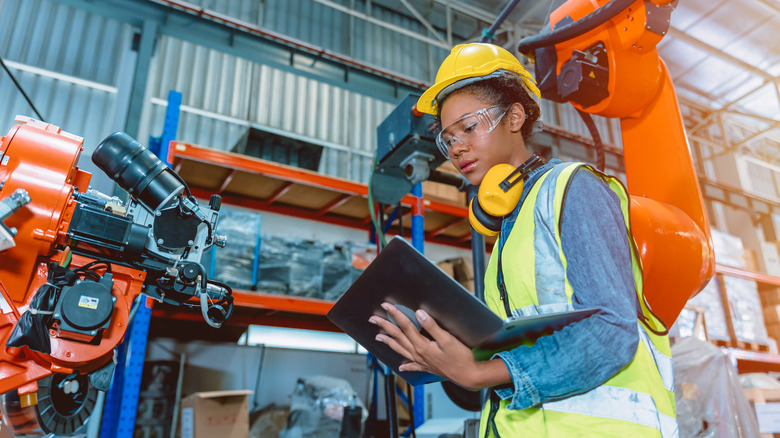What Is Digital Manufacturing? An Expert Engineer Explains
The development of more advanced AI has been making huge waves lately as the technology becomes integrated into more and more aspects of daily life. That includes personal computing, like with new Apple Intelligence features being utilized by iPhones and MacBooks, as well as in larger industries, such as the rise of AI in healthcare. With so many eyes on AI and machine learning, more and more people are also becoming aware of Industry 4.0 and the rise of digital manufacturing.
Digital manufacturing, according to Dr. Laine Mears, expert engineer and Automotive Manufacturing Chair at Clemson University, "is the use of data and information to make things faster, cheaper, and more consistent (i.e., of better quality)." Just as LLMs like ChatGPT have made it more efficient for you to search for the answers to questions from an unimaginable amount of data, digital manufacturing also uses data and computer systems to improve everything from the machines and processes used in physical manufacturing to the way machines and humans interact with one another.
As Dr. Mears explains, "This data can be, of course, local to the manufacturing operation (one machine can tell the next what to expect from what it observes, (termed per-part intelligence)), but also includes information on the design intent and customer needs so that processes can react to the true requirements, rather than just specification ranges for dimensions or functions (which lose the "why" aspect)." So, not only is digital manufacturing improving how things are made, but it's doing so broadly across several different stages of production, including how customers interact with them.
Digital manufacturing can be used to improve the production of a product from start to finish
Even before a product is built, digital manufacturing can help improve the way it's made. By using data analytics, digital manufacturing can be used by engineers who are designing a product well before it's produced and the materials used in its production are even sourced. With more efficiency in the design of a product, the entire life cycle of said product can be impacted — and enhanced — by digital manufacturing.
When it's actually time to build such a product, smart machines and sensors can use the principles of digital manufacturing to increase the efficiency of its production. As Dr. Mears says, "one machine can tell the next what to expect from what it observes," but machines on the assembly line can also provide feedback to human workers who are also integral to putting something together on a factory floor. This back-and-forth communication between humans and computers can then be used to analyze, track, and improve performance during the manufacturing of a product.
Digital manufacturing also includes value chain management, which is used to assess value and minimize resources through every stage of a product's development — integrating processes and slimming down inventories to save money and labor. Even customer demands can be evaluated to improve a product throughout its life cycle.
An Internet of People and Things can revolutionize mass production
Digital manufacturing can improve production processes both small and large, but the interaction of humans and machines may prove to be the most important aspect of all. "One newer dimension of digital manufacturing is bringing in information from humans in the operation and finding effective ways to share information back to them so that they can do a better job and find more enjoyment in their work," says Dr. Mears. "Transitioning [from] the Internet of Things to an 'Internet of People and Things' will make a big difference for mass production, of which people will always be a critical part."
While the idea of robots coming for people's jobs has been a looming threat — whether real or imagined — for some time now, digital manufacturing, according to Dr. Mears, can allow for just the opposite. Instead of being removed from the manufacturing process, people can "find more enjoyment" from their work based on data that is, in turn, formed from the input of those same people — creating a feedback loop between man and machine that is beneficial for both.
What are the benefits of digital manufacturing?
By being implemented in all stages of the production process, digital manufacturing can increase efficiency and reduce costs, as well as use analytics to make faster innovations and improve customer satisfaction. The digital interaction between businesses and customers can help the former understand and cater to the needs and wants of the latter, which can increase customer loyalty and brand awareness.
Real life examples of digital manufacturing include the use of cloud computing by the aerospace industry to streamline its vastly complex supply network. Suppliers and engineers can clearly communicate with one another, improving transparency and eliminating costly errors. Boeing developed both the 777 and 787 using all-virtual design, which reduced the time to market by more than half.
In addition to cloud computing, engineers can use AI and machine learning to more quickly understand why certain products or their components fail and adjust maintenance schedules or production processes accordingly, which increases operational efficiency and reduces costly energy consumption, among other benefits. This is just one reason why AI isn't just a passing fad and is here to stay.
According to McKinsey & Company, certain industry-leading companies utilizing digital manufacturing have seen 15%-30% increases in labor productivity, 30%-50% reductions in machine downtime, and 10-20% decreases in the cost of quality. These companies are likely also seeing increased revenue due to factors McKinsey considers "harder to measure," such as "increased flexibility to meet customer demand, faster speed to market, and better integration within the supply chain."
In other words, as Dr. Mears succinctly put it in his explanation of digital manufacturing, these companies are using "data and information to make things faster, cheaper, and [...] better quality."



